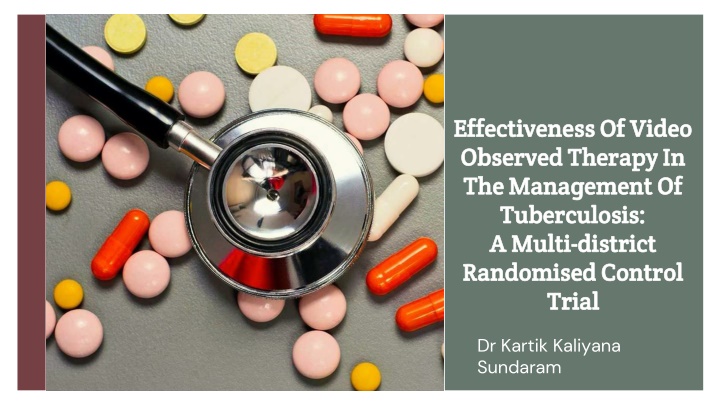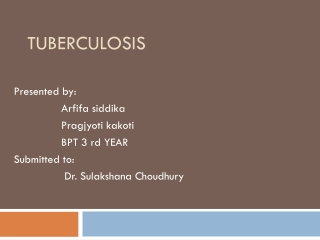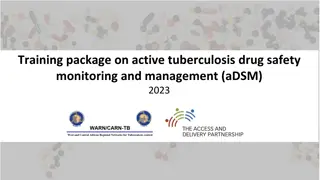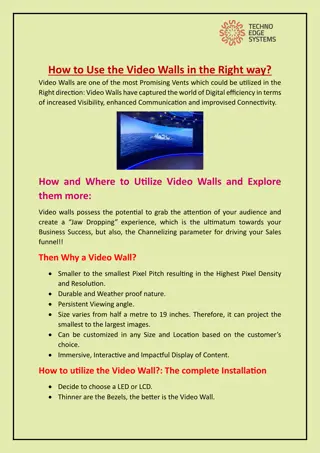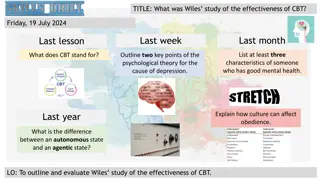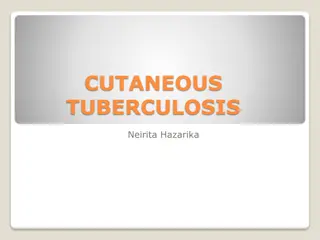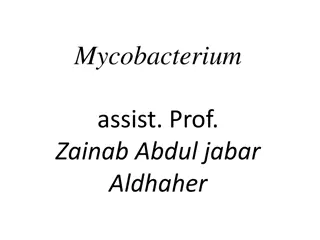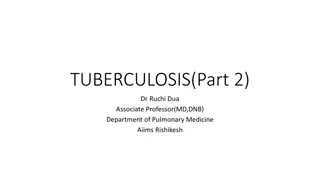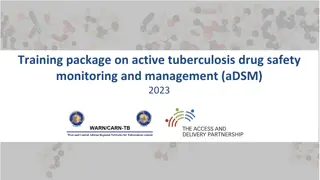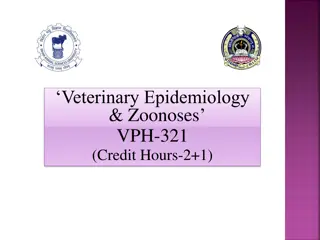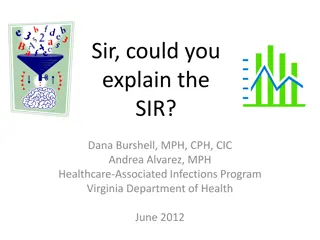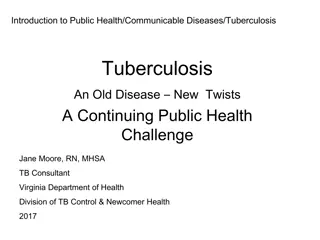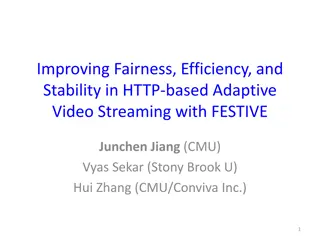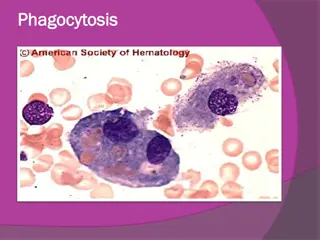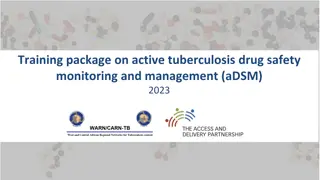Effectiveness of Video Observed Therapy in Tuberculosis Management
Tuberculosis (TB) remains a global health challenge with issues of treatment compliance, cost, and distance to healthcare facilities. A study comparing Video Observed Therapy (VOT) with traditional Directly Observed Treatment Short Course (DOTS) in TB management is conducted to improve compliance, reduce costs, and minimize COVID-19 transmission risk. Specific objectives include developing VOT intervention, comparing effectiveness with DOTS, and assessing patient satisfaction.
Download Presentation

Please find below an Image/Link to download the presentation.
The content on the website is provided AS IS for your information and personal use only. It may not be sold, licensed, or shared on other websites without obtaining consent from the author.If you encounter any issues during the download, it is possible that the publisher has removed the file from their server.
You are allowed to download the files provided on this website for personal or commercial use, subject to the condition that they are used lawfully. All files are the property of their respective owners.
The content on the website is provided AS IS for your information and personal use only. It may not be sold, licensed, or shared on other websites without obtaining consent from the author.
E N D
Presentation Transcript
Effectiveness Of Video Effectiveness Of Video Observed Therapy In Observed Therapy In The Management Of The Management Of Tuberculosis: Tuberculosis: A Multi A Multi- -district Randomised Control Randomised Control Trial Trial district Dr Kartik Kaliyana Sundaram
Background Background Tuberculosis (TB) is an infectious disease that is a major global health issue, The WHO estimates that there are approximately 1.8 million lives lost worldwide to TB in 2020 alone (WHO, 2020). DOTS is a method of drug administration where healthcare workers visually observe TB patients taking their daily cocktail of antibiotics over a duration of 6 months. However, compliance to DOTS still poses as a challenge,1 in 10 TB patients fails(Liew et al., 2015). Logistical issues, costs, and distance to healthcare facilities-factors for poor compliance.Report says patient need to spend an estimated RM3,010 (USD 725 (Elamin et al., 2008). What will happen if there is poor compliance? Repeat the entire TB regime if the patient missed >25% of treatment in a month Lead to multidrug TB resistance resulting in extended DOTS to 18 months. (Naing et al., 2001). (Chung-Delgado et al., 2015).
Research Justification Research Justification In Malaysia, the incidence rate of TB is 92/100,000, out of which the mortality rate is 3.69%. As reported in 2014, the number of patients with MDR TB was 160. The advent of a Video Observed Treatment (VOT), whereby a patient will be able to conduct live teleconference with healthcare provider and report their drug administration would be beneficial. A proposed intervention with VOT in TB treatment is a practical move as it can improve treatment compliance reduce treatment cost reduce the risk of COVID-19 transmission reduce the risk of COVID-19 infections
APPENDIX F: APPENDIX F: INSTRCTIONS FOR VOT INSTRCTIONS FOR VOT (ENGLISH VERSION) (ENGLISH VERSION)
Research Question Research Question What is the effectiveness of Video Observed Therapy (VOT) in the management of tuberculosis (TB) compared to the traditional Directly Observed Treatment Short Course Strategy (DOTS)?
General Objective General Objective The general objective of this study is to compare the effectiveness of VOT with traditional DOTS in the management of TB. Specific Objectives Specific Objectives To develop VOT intervention in the management of TB. To compare the effectiveness of VOT as compared to traditional DOTS. To measure patient s satisfaction using VOT.
Study Design Study Design This study will consist of two phases. Phase 1 of the study is the development of the VOT intervention. Phase 2 of the study will be comparing the effectiveness of VOT against traditional DOTS using a randomized controlled trial.
Phase 1: Development of the VOT Intervention Phase 1: Development of the VOT Intervention Expert Review This will be done using a focus group discussion (FGD) with selected experts. The experts that will be selected will be as follows, Respiratory physician from the Chest clinic Family medicine specialist Medical officer in charge of DOTS at a primary clinic Staff nurse or medical assistant from a DOTS team Health inspector of a district TB unit Digital health expert Extensive Literature Review Information regarding the barriers of traditional DOTS, evidence-based information will be identified, the need for intervention will be determined and the current practice will be gathered. The aim is to create an effective yet feasible VOT model for observing TB patients consuming their anti TB medication. The study will be done in two rounds with the first round starting with open-ended questions in groups and the second round with Likert scale rating questions.
Phase 2 Phase 2 Development of VOT process VOT= Video observed therapy, DOTS= Directly observed therapy, short course, FBC= Full blood Selection of participants count, RP= Renal profile, LFT= Liver function test Randomisation 1:1 Traditional DOTS VOT Monitoring DOTS clinic counselling and Baseline FBC, RP and LFT Repeat LFT at 2 weeks Repeat sputum AFB at the end of intensive phase Outcome Assessment Primary Outcome: To compare treatment adherence, to compare seroconversion of sputum smear positive to negative Secondary Outcome: Detection side effects, Degree of patient and provider s satisfaction, money and time spent by patient.
Study Outcome Study Outcome Primary Outcome Treatment adherence in percentage from both arms (Number of days medicine consumed/over 60 days intensive period). Secondary Outcome Number of successful sero-conversion patients from sputum smear positive to sputum smear negative by the end of the intensive phase. Number of reported side effects detected from both arms. Number of patients having side effects detected from both arms. The degree of satisfaction of the participants from both arms. Overall time spent by patients from both arms. Overall money spent by patients from both arm (self-reported).
Part 2 : Current progress Part 2 : Current progress Current hurdle : Financial / Grant to run research Cost of entire thesis : Rm 29,300 Rm 56,300
Study Budget Study Budget Item Description Cost(RM) Proposal Development Data Collection Printing Usage of application Sure Adhere app(KIV) Rental of phone(20),Laptop rental (10) 100 Rm 24,000 Usage of facilities Rm 14,400 Data analysis (by researcher) Internet package Preliminary report/ Final report Manuscript publication Research Assistant wage(KIV) Rm 3000 Internet usage (Rm 35X 240) Printing Rm 8,400 500 Submission fees Total 6000 RM 56,300 RM 29,300( without SureAdhere&RA)
Grant and its fate Grant and its fate First grant by Dr Wong,3rd SV Grant application was REJECTED by NIH Officially known in August 2022 Unsure the reason
Grant and its fate Grant and its fate Second grant applied with Selangor State Health Dept but REJECTED.
Grant and its fate Grant and its fate Submitted for Dr.Ranjeet Bhagagwan Singh Grant. Results STILL PENDING.
What is the Public Health Significance? What is the Public Health Significance? Tackling TB is one of the crucial health initiatives laid by WHO, and the Malaysian government is trying to focus completely on this. Innovative yet feasible innovation like this could lead to curing TB quicker and reducing the spread, thus, overall achieving the target END TB by 2035. Healthcare workers are burdened and under numbered. This study if successful could be adapted into the system, eventually reducing their burden without compromising the treatment. This will lead to reduction in job stress, mental health issues and improving quality of life. Holistic approaches can be adapted and expanded in the future by incorporating other vital records, TB contact tracing and cluster identification.
Thank you for your Thank you for your Attention Attention
